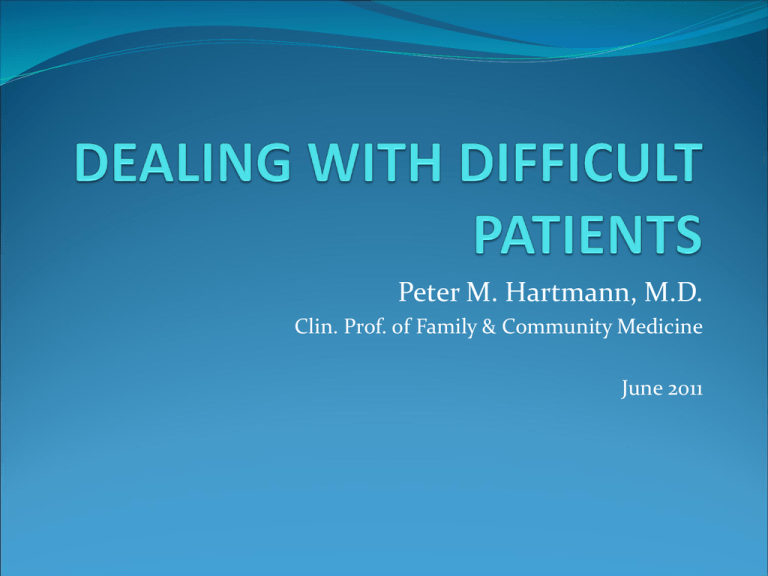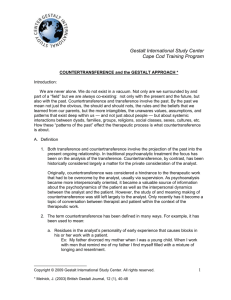
Peter M. Hartmann, M.D.
Clin. Prof. of Family & Community Medicine
June 2011
Objectives:
List three types of patients that
physicians typically find “difficult” to
deal with.
2. Describe effective strategies to
manage “difficult” patients.
3. Identify counter-transference issues
when dealing with “difficult”
patients.
1.
Case 1
26-year-old SWM prescribed alprazolam (Xanax) by
prior physician for panic disorder. He is unemployed
but talks grandly about job plans. He is charming and
likeable. You discover that he asks for refills early, calls
for refills on weekends, and has lost his medication 3
times (bounced out of convertible, girlfriend stole it,
and left it on train).
What further information do you want?
More History:
No prior history of drug abuse.
Never received DUI.
CAGE negative
General health good
Treated briefly as child for ADHD but parents did not
follow through.
Physical Exam:
BP 132/86 P 92 RR 12 Temp 99
degrees
Mesomorphic body build
Tattoo on right upper arm
No needle tracks, pupil abnormality,
diaphoresis, trauma, slurred speech, or
weight loss.
Lab studies:
Urine drug screen positive for
benzodiazepines
No other tests ordered.
ADDICTION
Diagnosis: Benzo Abuse
Respectfully confront patient with evidence
for abuse.
Tell him he has physiological dependence.
Initiate tapering regimen
a. Switch to clonazepam
b. Taper alprazolam by 25 % every 1-2 weeks
Consider random urine drug screens.
Prescribe SSRI for panic attacks.
Refer prn.
Other Management Issues:
Drug abuse patients often dishonest with
doctor.
Non-medical use of prescription drugs often
polydrug abuse (alcohol most common).
Disinhibited calls to office is sign.
Counter pressuring behaviors (begging,
excessive compliments, breech of
boundaries, vague or overt threats).
Have a plan in advance.
“Hide” behind authorities.
Be matter-of-fact with no tolerance for bad
behavior.
Stop prescribing immediately if dangerous
behavior (e.g., binging).
Illegal to give prescription for narcotics to
tide patient over until gets into treatment.
DOCUMENT!
Prescription Drug Abuse
Fastest growing form of drug abuse
among youth.
Typically found in medicine
cabinet.
Sickle Cell Anemia:
Case 2:
31-year-old SBM with sickle cell anemia
presents to your office wanting a
prescription for Percodan for pain. He has
required multiple hospitalizations for sickle
crises and is a fairly frequent visitor to the
ED for pain control.
You want to relieve his pain but worry about
him becoming addicted. What further
information do you want?
More History:
Having moderately severe pain in both elbows
No history of substance abuse.
Does not call for early refills.
Has had aplastic crisis in past from which he
has fully recovered.
Some fatigue and has chronic low grade
anemia.
No other health problems.
Physical Exam:
BP 142/92 P 99 RR 16 Temp 100 degrees
? Mild jaundice noted in conjunctivae
Poorly healing leg ulcers c/w sickle cell disease
Remainder of exam unremarkable
Lab studies:
Hct 28
Reticulocytosis
Sickled cells on smear
WBC 14, 000
Indirect bilirubin 1.5 (0.1-0.7)
Diagnosis: Sickle Cell Crisis
Consider hospitalization
Conflict between relieving pain and
avoiding addiction.
Opiate contract (see handout)
Flow chart
Opioid Risk Tool (Professional Graduate
Services)
Watch for addictive behaviors
New Patients:
Obtain old records
Don’t give > 1 day supply as emergency
Contract
See frequently
Limit number of providers seeing patient
“Difficult Patients”
Introductory Concepts
“Difficult” is in eye of beholder.
Often have psychiatric diagnosis.
Easier to cope if understand they are distressed
and not just a source of upset.
Learn clinical detachment; treat as symptom.
More Introductory Concepts
Transfer care if major problems.
Obtain consultation from colleagues or
mental health professional (Balint
Groups helpful).
Common types of difficult patients:
Patients who don’t get well.
Non-compliant patients.
Overly demanding patients.
Overly talkative and non-relevant talk
Drug seekers.
Borderline or narcissistic personality disorder.
Multiple medical problems (“too much time”).
Angry patients
Examples:
Clinical Case 3:
Mr. S., 54-y-o SWM is “frequent flyer” in ED and your
office. Usually, presents with atypical chest pain.
Normal cardiac cath. Multiple EKGs normal. He
appears again in your office without an appointment.
You know he is not having an AMI, but, “What if he is
this time?” Despite disrupting your schedule once
again you agree to see him. What should you do?
Somatoform Disorder:
a. Seeks reassurance and relationship with doctor.
b. Set limits.
c. Schedule regular visits even if no symptoms.
d. Recognize your countertransference
Case 4:
Ms T, a 64-yo-WWF is a “regular” in your
practice. She comes in every few weeks with
minor complaints. She also tends to talk
overly long and is quite tangential. At least
she is appreciative of your efforts, although
she comes across as being excessively
grateful. At the end of each session you feel
drained. She seems to treat the office visit
as a social call.
A Social Visit?
Dependent (Clinger):
Bottomless needs.
Seeks inexhaustible mother.
Tx: set reasonable limits: “Mrs Jones, we
have 10 minutes for your visit, what problem
would you like to address today?”
Case 5:
Ms M, a 24 yo SWF is the bane of your practice.
Initially, she praised you as the best doctor she had
ever seen. However, of late you seem to have fallen
off your pedestal. She frequent devalues you, and
you wonder why she still sees you. She demands to
be seen any time she wants and gets enraged if she
is made to wait. You find yourself arguing about
her with your nursing staff who think you are
unduly hard on her. They worry about her since
she has superficial scars from delicate self-cutting.
Entitled demanders
Narcissistic or borderline.
Use intimidation, devaluation and guilt-induction.
Patient unaware of deep dependency need (fear
abandonment).
Act as if had innate deservedness (shields them from
awareness of helplessness).
Borderline Personality Disorder:
Increased suicide risk
Use splitting
Projective identification
Black or white, all-or-nothing thinking
Emotional rollarcoaster
May have transient psychosis
Rage reactions common
Tx for Entitled Demanders
(borderline or narcissistic):
Rechannel entitlement to being entitled to best
medical care, which you will endeavor to provide.
Teach them not to “turn off” their caregivers.
Beware of splitting; always check out what they say
about others.
Co-manage with mental health professional.
Tx for antisocial manipulators:
Convey a sense of regard and respect.
Pick your battles.
Set clear and consistent limits in matter-of-
fact way.
Give choices (even pseudo-choice).
Case 6:
Ms J 32 yo bisexual SWF insists on seeing you whenever
she feels ill and won’t see any of y0ur partners since
you are “such a wonderful” doctor. You are
uncomfortable caring for her because she seems to
flirt with you and gives subtle hints that she finds you
sexy. Her medical complaints are difficult to pin down
since her history is always vague. You wonder if her
real problem is anxiety since she frequently complains
of being anxious in a very dramatic manner.
Histrionic
Overly emotional, flirtatious and sexually
provocative.
Vague historians (all forest, no trees).
Tend to be anxious.
Fear loss of attractiveness.
Tx of Histrionic
Set proper professional boundaries while
showing respect and regard.
Allow patients to dress up, use makeup, etc.
while in hospital or nursing home.
Do not act on their flirtation or sexual
provocativeness.
Case 7:
46-year-old MWM successful banker has
had to wait an hour in your waiting room.
When you enter the exam room he is
obviously angry. He berates you and your
staff and keep repeating, “My time is just as
valuable than yours!”
How should you manage this situation?
Managing Angry Patients:
Helpful techniques:
Always address anger; don’t ignore it.
Take a “one down” position and apologize
for real transgressions or for not meeting
patient’s expectations.
Correct mistakes when possible.
Avoid escalating anger.
Ask patient to speak more slowly since you
are having trouble following him.
More techniques:
Assess danger (prior history of violence,
escalating behavior, clenching fists, etc.);
Get help.
Arrange for both of you to be able to
“escape” room if necessary.
Pay attention to your gut feelings.
Be curious about the cause of the anger:
1. Real problem,
2. Borderline, narcissistic, or antisocial,
3. Drug addict,
4. Psychotic,
5. History of abuse
6. ADHD
7. PTSD
Countertransference:
Countertransference
Doctor’s attitudes and wishes based on past
relationships projected onto present ones.
Everyday occurrence.
Learn to pay attention to your feelings and
thoughts about patients. Use them (e.g., if you are
anxious, patient may be also).
Try to determine if feeling is “real” or a projection.
Countertransference Continued
Common signals of countertransference:
Using derogatory labels (“crock,” “druggie”).
Increased use of tests or referrals.
Acting differently than usual (more time, asking more
personal questions, avoidance).
Boredom, sleepiness, or irritability.
Excessive positive or negative feelings.
Countertransference continued
Dreams about patient.
Not understanding patient’s communication even
though no language barrier.
Over-identification especially if same age, sex, race,
etc.
Acting out with patient (sexual, romantic ,or other
boundary violation).
Final Thoughts
If you have been manipulated by a patient, you may be
angry with them and yourself.
These feelings are normal and natural.
Once recognized, forgive yourself (we have all been
manipulated at one time or another).
Treat manipulation as a symptom and be curious about the
cause.
Some benefit may accrue.
QUESTIONS ?









